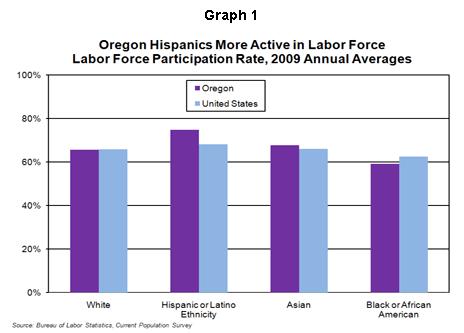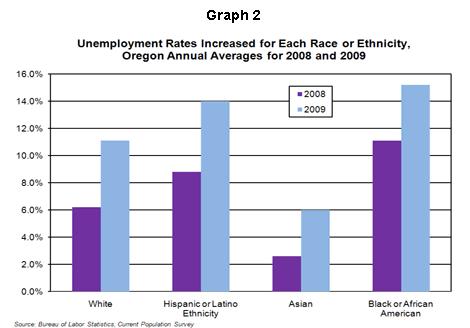Oregon’s unemployment rate jumped from 6.4 percent in 2008 to 11.5 percent in 2009 as the effects of the recession spread throughout the state. Unemployed Oregonians in all race and ethnicity groups struggled to find employment, but the labor market problems faced by blacks and Hispanics were especially difficult last year. The unemployment rate was 15.2 percent for blacks or African Americans and 14.0 percent for Hispanics or Latinos in 2009. These figures were considerably higher than the 11.1 percent unemployment rate for whites and the 6.0 percent unemployment rate for Asians.
According to the Bureau of Labor Statistics (BLS), the labor market difficulties of blacks and Hispanics are related to a variety of factors, not all of which are measurable. These factors include lower average levels of schooling, the tendency to be employed in occupations with high levels of unemployment, a greater concentration in the central cities of urban areas where job opportunities may be limited, and the likelihood of experiencing discrimination in the workplace. These and other factors may make it especially difficult for some black and Hispanic workers to find or keep jobs during economic downturns.
Estimates derived from the BLS’s Current Population Survey are used to describe some of the labor force characteristics of the state’s major race and ethnic groups. In some cases, the large error ranges around these sample-based estimates makes it difficult to know for sure if differences actually exist between the employment statuses of the various groups.
The overall labor force participation rate of Oregon residents was 65 percent in 2009, exactly the same as the nation’s rate. Among the major race and ethnicity groups, Hispanics had the highest labor force participation rate at 75 percent, followed by Asians at 68 percent, whites at 66 percent, and blacks at 59 percent.
Oregon’s Hispanic labor force participation rate was higher than the nation’s 68 percent and the state’s Asian participation rate was slightly higher than the nation’s 66 percent, as shown in Graph 1. The participation rate of blacks in Oregon was slightly lower than the nation’s 62 percent rate, and the participation rate of whites was virtually the same.
The labor force participation rate is the percent of the civilian noninstitutional population that is either employed or unemployed. The civilian noninstitutional population includes persons who are 16 years and older, and who are not confined to nursing homes and prisons, or in the Armed Forces.
Increases in unemployment rates were seen in each race or ethnicity group in Oregon between 2008 and 2009. The unemployment rate for Asians more than doubled from 2.6 percent to 6.0 percent, an increase of 3.4 percentage points and the smallest increase for any group. The unemployment rate for blacks increased from 11.1 percent to 15.2 percent, an increase of 4.1 percentage points, and the rate for whites grew from 6.2 percent to 11.1 percent, an increase of 4.9 percentage points. Hispanics saw the largest increase in unemployment rates, rising from 8.8 percent in 2008 to 14.0 percent in 2009, an increase of 5.2 percentage points.
Oregon’s unemployment rate averaged 2.2 percentage points higher than the nation’s during 2009. Among the major race and ethnic groups, the unemployment rate was 2.6 percentage points higher among whites in Oregon when compared to the nation, 1.9 percentage points higher for Hispanics, and 0.4 percentage point higher for blacks. Only the Asian group had a lower unemployment rate, 1.3 percentage points below the national unemployment rate for Asians.
The unemployment rate is the share of the labor force that has no employment, is available for work (except for temporary illness), and made efforts to find employment sometime during the four weeks prior to being surveyed. However, people waiting to be recalled from a layoff do not need to be looking for work to be considered unemployed.
Disclaimer: Articles featured on Oregon Report are the creation, responsibility and opinion of the authoring individual or organization which is featured at the top of every article.





